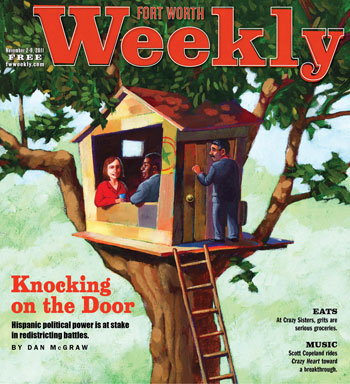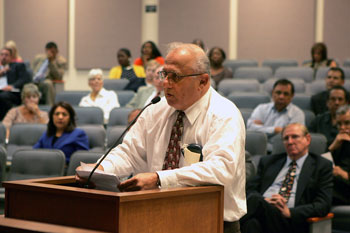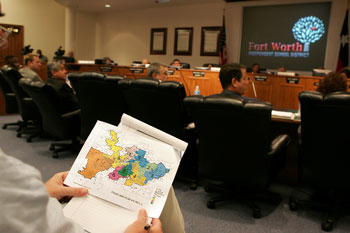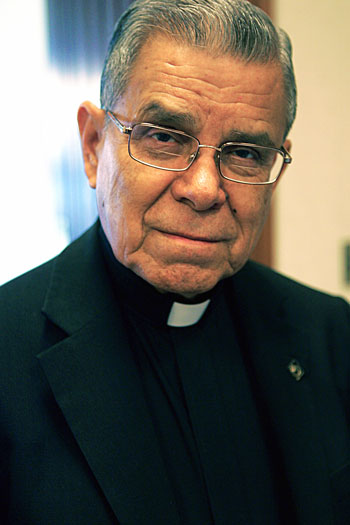Contention is always on the agenda in Fort Worth’s halls of government, whether the question is gas wells, bullying, budget woes, or eminent domain. But in the last few weeks, the heat has been turned up on an even more nuts-and-bolts topic, at least from elected officials’ point of view. That would be politics, neighborhoods, and race. In other words, redistricting.
 It’s a process that rolls around once a decade, after new U.S. census results are released, and it’s usually a bare-knuckles fight, with incumbents wrestling to keep the constituents who will keep them in office, political parties trying to get headlocks on one another, and out-of-power voter groups scrabbling to increase their share of the electoral pie.
It’s a process that rolls around once a decade, after new U.S. census results are released, and it’s usually a bare-knuckles fight, with incumbents wrestling to keep the constituents who will keep them in office, political parties trying to get headlocks on one another, and out-of-power voter groups scrabbling to increase their share of the electoral pie.In Fort Worth and Tarrant County this time, there is a common, constant theme to the redistricting debates: how to deal with the growing strength of the Hispanic vote. In the last decade, Hispanics have been at the forefront of Fort Worth’s huge growth. Their percentage in the Fort Worth population rose from 30 to 34 percent between 2000 and 2010, and Hispanics accounted for almost half of the 200,000 new citizens.
The same phenomenon — and the same fight — is taking place at other levels: Last week the U.S. Department of Justice ruled that Texas’ redistricting plans for its congressional delegation and Texas House and Senate seats, pushed through by the Republican-dominated legislature, discriminate against minorities. Hispanic groups have already sued to stop the plan, and the action involves the fate of State Sen. Wendy Davis’ district: The Republican plan would remove the heavily Hispanic and African-American areas of Fort Worth that voted heavily for her in the past and replace them with whiter, more conservative parts of the region.
There’s nothing ivory-tower or theoretical about these arguments: Redistricting can have huge, long-lasting impacts on the financial and social future of parties, cities, and racial groups. This time, in addition to the federal lawsuits, everything from charges of racism, arguments about the power of downtown versus neighborhoods, a potential city charter election, and even death threats have been thrown into the mix.
At the Fort Worth school district, trustees voted last year to move away from the current arrangement of eight single-member districts plus a board president elected at large. The new plan would include nine single-member districts, with the president chosen by the trustees themselves from among their number. That adds an extra single-member district seat and reduces somewhat the ability of downtown and other money-heavy groups to influence the district by way of electing the board president.
But reshaping eight districts into nine is anything but easy — parents want the person who represents them geographically to also represent the schools their children attend, for instance. Juggling those issues plus the need to fairly apportion minority voting strength makes for quite a jigsaw puzzle.
Last week trustees, on a 5-4 vote, approved a plan that gives Hispanics, blacks, or a combination of those two groups a majority in six of nine districts. Given the historic tendency of minority groups to vote in smaller numbers than whites, that might or might not produce Fort Worth’s first majority-minority school board. Hispanics and African-Americans now account for 85 percent of students in Fort Worth public schools.
At city hall, Hispanic activists and others are also pushing to increase the number of single-member seats, from eight to 10. Despite a city-financed survey that found a strong majority of residents in favor of added seats, the council will decide that issue without even looking at the maps of potential districts. The reasoning: Adding another council member would cost a lot of money for such things as reconfiguring city council chambers and would also necessitate a city charter election. On Nov. 15, the council is set to vote on whether to add the two extra seats, but not on how to re-divvy the city to add the new districts. At Tuesday’s pre-council meeting, sentiment seemed to be against the new districts.
Jason Smith, a local attorney who has worked extensively on voting rights issues, said Fort Worth “has to realize what it is and what it will become. It is a minority-majority [city], and many are afraid of being a minority-majority city. We have to change with the times, and those changes might mean the longtime power brokers might lose some of their influence.”
But they won’t lose a lot, he said, “because they know how to protect it.”
Fernando Florez, president of United Hispanic Council of Tarrant County, is involved in both the city and school board fights. He said his organization will back the new school district plan when the DOJ reviews it. But if Fort Worth stays with the eight-district plan, he said, the city council should expect a lawsuit.
“We don’t want to go that route, but as I have said, the time is now,” he said. “We cannot wait another 10 years with under-representation.”
The Justice Department, with its decision to oppose the state’s legislative and congressional redistricting plans, has already served notice that it intends to weigh in on Texas’ redistricting process.
In fact, Texas is one of nine states, mostly in the South, that, under the Voting Rights Act, automatically qualify for extra DOJ scrutiny because of past patterns of racism — mostly in the 1960s and ’70s — in their treatment of voting and election decision-making. All states and political subdivisions must comply with the act, but those nine states have to get pre-clearance from the justice agency before implementing any electoral change.
So for the city council and school board, the threat of a federal veto of whatever plans they come up with is real, a large yellow warning sign that presumably affects their deliberations.
Last month the Tarrant County Commissioners Court made minor tweaks to their four districts (the county judge is elected countywide). They also had to look at the makeup of the constable precincts. Some Arlington residents wanted to redraw two precincts there to raise the minority population percentage in one district, but commissioners rejected that plan. All those plans will have to be approved by the DOJ.
Compliance with the Voting Rights Act is complicated. With Hispanics making up 34 percent of the city population, for instance, a map that gave Hispanics 34 percent of the voters in each district would do exactly the opposite of what the act intends: Given the strong proclivity of voters to cast ballots for candidates of their own race, the likely outcome of such a system would be for Hispanics to win no seats on the council, instead of holding about 34 percent of the spots. On the other hand, sticking almost all Hispanics in one district, giving them a very large percentage of the vote there but almost none elsewhere, would also violate the act, since it would probably mean that only one Hispanic would likely be elected, instead of giving them a fair chance at more seats.
Nor is it sufficient to give a minority group a mere majority of the voters in, say, a third of the districts. Hispanic leaders have long maintained that districts with less than 50 percent representation provide little chance of a Hispanic being elected. The Hispanic population is younger, about 10 percent of them in Tarrant County aren’t citizens, and they don’t vote as much as affluent whites. Even in districts with 55 percent Hispanic population, leaders say, the higher turnout rates of affluent neighborhoods could cancel out that numeric advantage.
“The U.S. Supreme Court has ruled in the past that voter turnout can be a factor when deciding if the redistricting maps comply with the Voting Rights Act,” Smith said — although how much weight can be given is still vague.
One key term is “retrogression,” meaning that newly drawn districts first and foremost cannot reduce the number of minority elected officials.
“What we will argue is that if Hispanic voters think they have at least a chance of winning an election, voter turnout will go up and be less of an issue over time,” said Rolando Rios, a San Antonio civil rights attorney representing the United Hispanic Council of Tarrant County.
On the night of the Oct. 25 school board meeting, redistricting had come down to a very personal concern for a bunch of Paschal High School parents.
 Three largely Anglo, upper-middle-class neighborhoods — Berkeley Place, Mistletoe Heights, and Park Hill — had been removed from the new District 9, which would run from the North Side south to Hemphill Avenue, connecting Fort Worth’s two strongest centers of Hispanic voters. Hispanic leaders agreed that removing the Anglo-dominated neighborhoods would raise the new district’s Hispanic population share to more than 65 percent.
Three largely Anglo, upper-middle-class neighborhoods — Berkeley Place, Mistletoe Heights, and Park Hill — had been removed from the new District 9, which would run from the North Side south to Hemphill Avenue, connecting Fort Worth’s two strongest centers of Hispanic voters. Hispanic leaders agreed that removing the Anglo-dominated neighborhoods would raise the new district’s Hispanic population share to more than 65 percent.
But those neighborhoods lie in the Paschal High School attendance zone, and the proposed change would move residents of those neighborhoods into the district of a board member who doesn’t represent Paschal.
The Hispanics argued that Paschal High School isn’t really a neighborhood school because it houses several special programs, including a well-recognized honors program, that draw students from throughout the district.
Neither side would budge. Rios told the board that keeping those neighborhoods in District 9 would dilute Hispanic voting strength to 63 percent and might be turned down by the DOJ. Trustee Judy Needham proposed at the meeting that the three neighborhoods be put back in the new district, and Rios vowed to fight that change in federal court if it went through. But Needham’s proposal never even came to a vote.
Paschal parents were angry that the board would even consider such a plan. “They say that democracy dies with a whimper,” said Ed Lasater, an attorney who helped organize a group calling for more civility from the school board. His kids will attend Paschal in a few years. “This is racial gerrymandering,” he said.
“When you disenfranchise voters like you are doing to many Paschal High School parents, you are taking away their rights, and they will send their kids to private schools,” Lasater told the board. “To divide this community based on race is abhorrent.”
Florez said that the seemingly insignificant reduction in the percentage of Hispanic voters would be enough to make it much harder for a Hispanic candidate to be elected.
“In other words, in substantial numbers, whites vote for whites, blacks vote for blacks, and Hispanics for Hispanics,” Florez said. “Is that right? Of course not. But that is the reality now, and we have to deal with it.”
During the debate, several trustees made sure the audience understood how ugly the fight had gotten.
Juan Rangel told the audience that Rios had been threatened by angry parents in the parking lot after a previous meeting, and a security guard had to break up the confrontation. Carlos Vazquez said he’d received anonymous death threats over redistricting, though he wouldn’t go into specifics.
Trustee Ann Sutherland angered some and confused others by saying the board needed to pass the plan supported by Hispanic leaders because “the schools belong to the people of Fort Worth, and these people no longer look like me.” After some in the audience suggested the comment was racist, she clarified the comment. She said she meant that the board must reflect the race and ethnicity of the voting age population and of students within the district.
The Rev. Kyev Tatum, president of the local chapter of the Southern Christian Leadership Conference, told trustees that the new school board “should be four Latinos, two African-Americans, and three Anglos.” Texas has a long record of ignoring the interests of minorities, and that has to change, both statewide and locally, he said. “Local issues are where the change needs to begin.”
The nine-district plan eventually passed on a 5-4 vote, with Sutherland voting for it. Rios promised that the Hispanic leadership in Tarrant County would not fight the plan in court and would file a brief with the DOJ supporting it.
The plan as approved could substantially change the makeup of the board. Six of the nine districts would have a 70 percent minority voting-age population, combining Hispanic and black voters (compared to four districts currently). Of those, three would have Hispanic populations topping 60 percent and a fourth more than 50 percent.
The current board includes two Hispanics and two African-Americans among its eight single-member district trustees. The board president is also white.
After the vote, Florez turned to a mother of a Paschal student and offered an olive branch. “We should meet and air out and discuss our differences so that we can all move forward without this distrust I am feeling,” he told her.
“I am not talking to you, because you don’t represent me,” said the mother, who wouldn’t give her name to this reporter.
“I don’t want to represent you,” Florez responded. “We are both Americans, and we care about our children’s education. We have to find some common ground.”
The mother seemed more irritated: “I don’t think you care about kids, just politics. So I don’t think we have anything in common, and I don’t want to talk to you.”
Father Stephen Jasso, pastor of the largely Hispanic All Saints Catholic Church on the Near North Side, said afterward that larger issues are at play.
“We need to get parents and their children more active in the schools, and when they are under-represented on this board, they are less likely to be involved,” he said. “This is a first step, but we can use this first step to help make our schools better.”
The city’s redistricting battles have taken a different turn from the school board’s, in large part because the city council thus far has resisted calls for more districts to be added to the council.
Council redistricting must address the city’s massive population growth. Since the current eight single-member districts were created here in 1975 (to stave off what probably would have been forced change under the Voting Rights Act), Fort Worth’s population has nearly doubled. In 1980, the average population in each council district was about 40,000; now it’s more than 92,000. Some argue that such population increases make it hard for elected officials to respond to citizen concerns effectively.
“Keeping the eight-district plan dilutes the influence of voters because they have less ability to interact with their elective officials,” said Florez. This is even more true for minority groups, he said, because the current districts were drawn to mix white affluent neighborhoods in with inner-city minority ones, thus reducing minority candidates’ chances of getting elected.
Florez, council member Sal Espino, and other Hispanic leaders, not surprisingly, want the new plan to be reflect Hispanics’ growing political numbers. Between 2000 and 2010, Hispanics’ share of the population rose from 30 percent to 34 percent while African-Americans’ dropped from 20 to 18 percent and Anglos’ share decreased from 45 to 42. The council makeup currently includes one Hispanic, two African-Americans, and five Anglos, plus the mayor, who is elected citywide. Espino is the only council member to come out in favor of adding two more seats.
Mayor Betsy Price had supported expansion of the council during her recent campaign, but she seems to have flip-flopped. Despite the recent city survey showing that 69 percent of residents favor adding the two seats, Price said in an e-mail to Fort Worth Weekly that she is not hearing that support from voters. She said she wants to listen to both sides before deciding.
The plan presented by Florez and his group would create a new South Side district with a voting-age population that’s about 60 percent Hispanic. A second new district would represent the city’s far North Side, around the booming Alliance Airport.
 At their pre-council meeting this week, four council members said they’d vote to keep the current number of districts, and Price said she’s leaning that way.
At their pre-council meeting this week, four council members said they’d vote to keep the current number of districts, and Price said she’s leaning that way.
Danny Scarth said he favors keeping the current setup “because larger districts provide more diversity.”
Libby Willis, president of the Fort Worth League of Neighborhoods, said that at a league meeting in September, attendees favored expansion by a 100-1 vote.
“The population has exploded, and it makes sense … that we are growing into a big city and [need] a system that deals with that,” she said.
City staff and council members focused the debate on the added cost of council expansion. Staffers estimated one-time costs of $400,000 to $600,000 for such things as redesigning council chambers and buying office furniture and high-tech equipment for two new offices. In addition, the extra council positions would cost the city about $184,000 a year for staff salaries, benefits, and expense accounts. That’s a drop in the bucket based on the city’s current annual budget of more than $1.2 billion — but the city has also faced recent severe budget cuts. Whatever changes are made to the city’s political map, they won’t be reflected at the polls until council elections in May 2013.
Those estimates, of course, don’t figure in what the city could pay in legal bills to defend the eight-district plan in court.
“Many neighborhoods have had a problem with the delivery of services, but the council seemed more focused on the cost of adding two more districts,” Willis said. “I don’t think that should have been a factor.”
Still the question of higher costs apparently is persuasive to some. “It is not the right time to expand the council,” said Eunice Givens, director of government affairs for the Highland Hills Neighborhood Association. “I think council is working quite well right now, and the city is cash-strapped.
“The cost to me was just too much, when they can’t fix my street,” she said. “Right now, they need to draw up fair boundaries under the eight-member council with the current population and do it in such a way to protect minority interests.”
 Alyce Boyd, president of the Ryanwood Neighborhood Association on the city’s East Side expressed a similar view. “Ten districts might make the city more efficient, but we can’t afford it,” Boyd said. She said most people in her neighborhood don’t support the change, “but it also wasn’t a really big issue to most people.
Alyce Boyd, president of the Ryanwood Neighborhood Association on the city’s East Side expressed a similar view. “Ten districts might make the city more efficient, but we can’t afford it,” Boyd said. She said most people in her neighborhood don’t support the change, “but it also wasn’t a really big issue to most people.
“Our councilman [Danny Scarth] works very hard, and we are generally pleased with him,” Boyd said.
One of the crucial issues in redrawing the current districts is the city’s historical practice of creating districts that combine inner-city neighborhoods with areas outside Loop 820. The city staff proposals, posted on the city’s web site, would continue that practice. Those proposals probably would not result in much change in the racial makeup of the council.
Council member Dennis Shingleton said that districts that combine urban neighborhoods and suburban sprawl are in the best interest of the city. “Having districts completely outside the loop would disenfranchise those people and reduce their influence,” he said. “Having different groups within the districts aligns these groups with thinking about the greater good of the city.”
That argument is debatable. Take District 2, for example. Espino’s district runs from the Tarrant County College’s downtown campus up into Denton County, past the Texas Motor Speedway. So he represents poorer Hispanic neighborhoods inside Loop 820 and the more affluent homeowners near Alliance Airport. The interests and needs of those two groups can be very different.
His district grew from 68,000 people to 152,000 between 2000 and 2010. “We hear more about city problems, from road construction to basic service delivery, on the Far North Side than anywhere else in the city,” Willis said.
If no new districts are added, population should average about 92,000 per district. That means about 60,000 residents of the current District 2 would have to be moved to another district. Ten districts would bring the average population down to about 74,000.
“I don’t think council has thought of the ramifications of not going to the 10-district system,” Espino said. “They have to move about 60,000 out of my district, and those will have to go into District 7 [on the West Side]. Then that district will have way too many people, and we’ll have to move people south. And then, move more people to the east.” He calls the movement “a counterclockwise” plan that will change every district.
“If we go with 10 districts, most people in this city will remain in the district where they were before,” Espino said. “We have grown into a big city and have to start acting like one. Two more districts would result in better representation, better city services, and the cost would be a good investment in this city.”
Espino wants the 10 versus eight debate to go before voters in the spring. Sample district plans could be drawn to show voters the possible changes, he said.
Because adding districts would require a city charter election, Espino said that it makes sense to ask for voter approval of that change before going to the trouble of drawing up possible 10-district maps.
One of the arguments being made in the background is that if Hispanic leaders want another seat on city council, they should do a better job of getting their people out to vote. Three of the eight districts currently have a Hispanic population of more than 45 percent.
Local redistricting is “an ugly process” because local politicians are “protecting their own bailiwick and trying to make sure they can get re-elected with the new districts,” said University of Texas at Arlington political science professor Allan Saxe. Incumbents have built up voter databases of their current districts, and it’s a lot more work to relearn and get the word out to a new set of voters, Saxe said.
Saxe said the courts have waffled on the issue of how much weight to give arguments of differing voter turnout records among ethnic groups.
“The courts have usually ruled that you can make it likely [that a minority candidate is elected], but you don’t need to ensure that,” he said. “What that percentage of minority voters within a district might have to be to comply with the Voting Rights Act is unclear. It would have to be over 50 percent. But moving it up to the high 60s might be too far.”
Rios said that any proposed city council districts that combine areas inside and outside Loop 820 will not pass DOJ muster and will be fought by local Hispanics.
“Based on the Hispanic population in Fort Worth, the Hispanics should have at least two, possibly three seats on council,” he said.
Another issue being talked about quietly is the role African-American voters will play in determining the new districts. One Hispanic leader, who asked not to be named, said African-Americans “are afraid that they would have lost power under a 10-district plan, because they would have two seats out of 10 instead of two out of eight.”
But Givens, who is black, said Hispanics could have “half the seats on city council if they just turned out to vote. We have a growing Hispanic population in our neighborhood, but they just don’t seem to care about local issues.”
The city council “could redraw districts that have 60 percent Hispanics, but I think they would still lose,” she said. “Blacks have a better history of voting here in Fort Worth, and we are more active in community issues. I’m not against them getting more seats at the table, but you have to earn it.”
Florez said the city redistricting fight is “very much in flux.” If the council stays with eight districts, they should expect to be sued, he said. “This is a fight I’ve been pursuing for more than 25 years.
“My family came to this country before the Declaration of Independence,” he said. “I’ve served in the military and taught high school, including 10 years at Paschal. What I find insulting is that people are making this a race issue by portraying Hispanics as people who can’t speak English and who don’t care about their community.
“We do care about this city and our communities,” he said. “But in order for our people to get more engaged, they need to see one of their own with a seat at the table. And that’s all we’ve been asking for. One more seat. I don’t think that is too much to ask.”
Sergio De Leon, a longtime Democrat and constable in Precinct 9, said larger issues are at play in Tarrant County than the details of constable workloads or city budget impacts.
“We want responsive government, and any changes must reflect that goal,” he said. “But responsive government must also reflect different communities of interest. In Fort Worth, the downtown business interests and the white West Side have always gotten anything they wanted. The inner-city areas with large minority populations have largely been ignored. But all of that needs to be changed, because this city is changing.”











